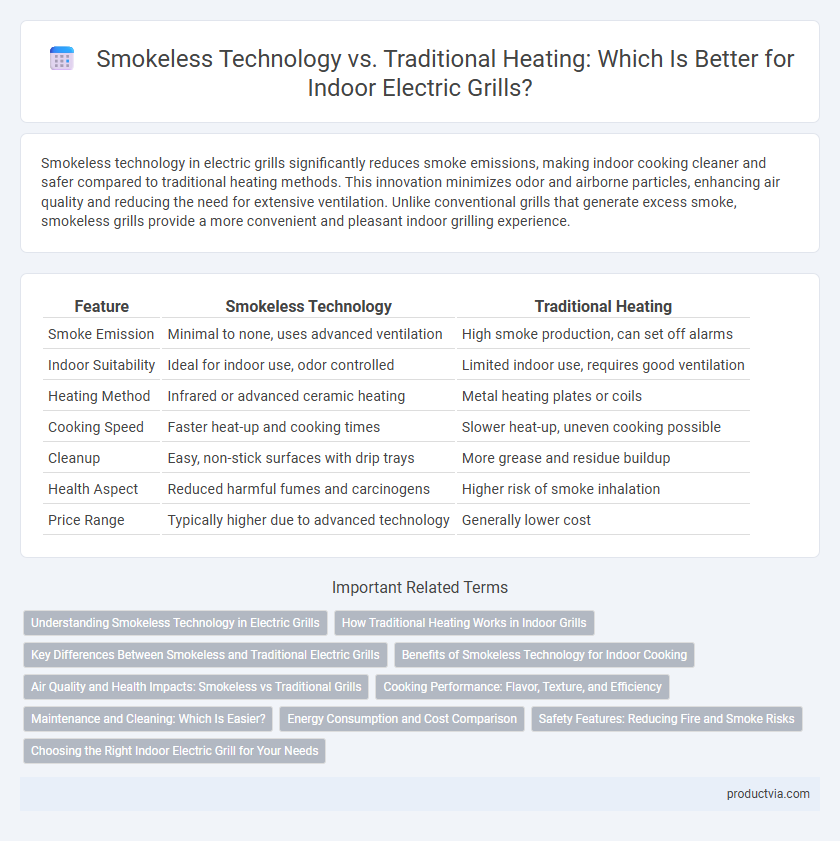Smokeless technology in electric grills significantly reduces smoke emissions, making indoor cooking cleaner and safer compared to traditional heating methods. This innovation minimizes odor and airborne particles, enhancing air quality and reducing the need for extensive ventilation. Unlike conventional grills that generate excess smoke, smokeless grills provide a more convenient and pleasant indoor grilling experience.
Table of Comparison
| Feature | Smokeless Technology | Traditional Heating |
|---|---|---|
| Smoke Emission | Minimal to none, uses advanced ventilation | High smoke production, can set off alarms |
| Indoor Suitability | Ideal for indoor use, odor controlled | Limited indoor use, requires good ventilation |
| Heating Method | Infrared or advanced ceramic heating | Metal heating plates or coils |
| Cooking Speed | Faster heat-up and cooking times | Slower heat-up, uneven cooking possible |
| Cleanup | Easy, non-stick surfaces with drip trays | More grease and residue buildup |
| Health Aspect | Reduced harmful fumes and carcinogens | Higher risk of smoke inhalation |
| Price Range | Typically higher due to advanced technology | Generally lower cost |
Understanding Smokeless Technology in Electric Grills
Smokeless technology in electric grills employs advanced infrared heating elements and enhanced airflow systems to reduce smoke production significantly compared to traditional heating methods. This technology minimizes grease vaporization by directing heat more evenly while using non-stick surfaces that limit burning, resulting in cleaner indoor cooking environments. Electric grills with smokeless technology offer a healthier, odorless, and more convenient alternative for indoor grilling without compromising the taste and texture of grilled foods.
How Traditional Heating Works in Indoor Grills
Traditional heating in indoor electric grills relies on exposed metal heating elements that generate direct radiant heat, which cooks food through conduction and radiation. This method often produces smoke and odors due to fat and juices dripping onto the hot elements, causing combustion. The direct contact with high temperatures provides rapid heating but may require ventilation to manage smoke and prevent indoor air quality issues.
Key Differences Between Smokeless and Traditional Electric Grills
Smokeless electric grills utilize advanced infrared heating technology that significantly reduces smoke production compared to traditional electric grills, which rely on direct heating elements that often generate smoke from grease and food residue. The smokeless design incorporates effective drip trays and enhanced ventilation systems to minimize smoke and odors, making it ideal for indoor use without triggering smoke alarms. Traditional electric grills typically require more frequent cleaning due to higher smoke emissions and grease buildup, whereas smokeless grills promote a cleaner, healthier cooking environment.
Benefits of Smokeless Technology for Indoor Cooking
Smokeless technology in indoor electric grills significantly reduces smoke emissions, creating a cleaner cooking environment that improves indoor air quality and minimizes the need for ventilation. This technology utilizes advanced heating elements and airflow design to efficiently cook food while preventing the production of smoke and unpleasant odors. Compared to traditional heating methods, smokeless electric grills enhance safety, reduce cleanup, and enable healthier cooking by reducing carcinogenic smoke exposure.
Air Quality and Health Impacts: Smokeless vs Traditional Grills
Smokeless technology in indoor electric grills significantly reduces airborne pollutants, minimizing exposure to harmful particulate matter and volatile organic compounds compared to traditional heating methods. Improved air quality from smokeless grills lowers respiratory risks and enhances overall indoor health, particularly for individuals with asthma or allergies. Traditional grills often emit smoke and toxins that can aggravate respiratory conditions and contribute to indoor air pollution.
Cooking Performance: Flavor, Texture, and Efficiency
Smokeless technology in indoor electric grills enhances cooking performance by maintaining consistent heat distribution, which preserves the natural flavors and tender texture of grilled foods. Unlike traditional heating methods that often cause uneven cooking and smoke, smokeless grills optimize efficiency by reducing flare-ups and ensuring faster cooking times. This innovation leads to healthier meals with improved taste and minimal indoor air pollution.
Maintenance and Cleaning: Which Is Easier?
Smokeless technology electric grills typically feature non-stick surfaces and detachable components that simplify cleaning, reducing grease buildup compared to traditional heating elements. Traditional indoor electric grills often require more effort to remove charred residues and grease from fixed heating coils, increasing maintenance time and complexity. The advanced design of smokeless grills enhances user convenience by minimizing residue and facilitating easier cleanup.
Energy Consumption and Cost Comparison
Smokeless technology in indoor electric grills typically consumes 20-30% less energy compared to traditional heating methods, resulting in lower electricity bills and enhanced efficiency. Traditional heating elements often require higher wattage and longer cooking times, increasing overall energy costs. Investing in smokeless electric grills reduces long-term operational expenses while maintaining consistent cooking performance.
Safety Features: Reducing Fire and Smoke Risks
Smokeless technology in indoor electric grills significantly reduces fire and smoke risks by incorporating advanced heat distribution and non-flammable materials, ensuring safer cooking environments compared to traditional heating methods. Traditional electric grills often generate excess smoke and hotspots, increasing the likelihood of fire hazards and indoor air pollution. Prioritizing grills with smokeless technology enhances indoor safety, minimizes smoke inhalation, and lowers the risk of accidental fires.
Choosing the Right Indoor Electric Grill for Your Needs
Smokeless technology in indoor electric grills uses advanced infrared heating and effective smoke filters to minimize smoke production, making it ideal for apartment living and small kitchens. Traditional heating elements generate more smoke and heat, which may require better ventilation and limit indoor use. Selecting the right indoor electric grill depends on your cooking style, space constraints, and preference for smoke control, with smokeless models offering cleaner, more convenient grilling experiences.
Smokeless technology vs traditional heating for indoor electric grills Infographic

 productvia.com
productvia.com